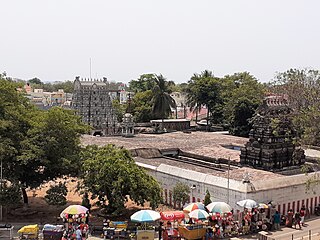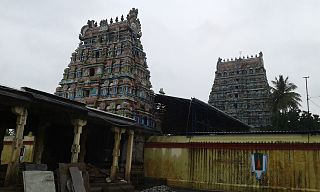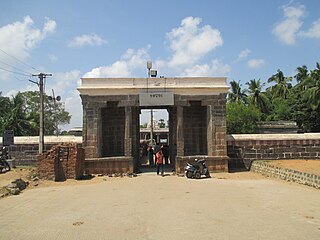
Namakkal is a city and the headquarters of Namakkal district, Tamil Nadu. It is the first ISO 14001-2004 certified municipality in Asia for environmental management, specifically the provision and maintenance of water supply, solid waste and sewage management, town planning, lighting and other social services. Namakkal is known as the Egg City due to its large egg production and Transport city.

Namakkal District is one of the 38 districts in the state of Tamil Nadu, India. The district was bifurcated from Salem District with Namakkal town as headquarters on 25 July 1996 and started to function independently from 1 January 1997. The district has eight taluks (subdivisions): Tiruchengode, Namakkal, Rasipuram, Paramathi Velur, Sendamangalam, Kumarapalayam, Kolli Hills and Mohanur. It has two revenue divisions: Tiruchengode and Namakkal. As of 2011 census, Namakkal district had a population of 1,726,601 with a sex-ratio of 986 females for every 1,000 males and Tiruchengode is the largest city in terms of population. Namakkal district is geographically affiliated to Kongu Nadu region. The district is famous for its large poultry industry, egg production and lorry bodybuilding industry, for which it is often referred to as "Egg City" and "Transport Hub of South India".

Sthalasayana Perumal Temple is at Mahabalipuram. Constructed in the Dravidian style of architecture, the temple is glorified in the Naalayira Divya Prabandham, the early medieval Tamil canon of the Alvar saints from the 6th–9th centuries CE. It is one of the 108 Divya Desam dedicated to Vishnu, who is worshipped as Sthalasayana Perumal and his consort Lakshmi as Nilamangai Thayar. The temple is believed to have been built by the Pallavas, with later contributions from the Medieval Cholas, Vijayanagara kings, and Madurai Nayaks.

Thirukkadigai or Sholingapuram in Sholinghur, a village in Vellore district of the South Indian state of Tamil Nadu, is dedicated to the Hindu god Vishnu. Constructed in the Dravidian style of architecture, the temple is glorified in the Naalayira Divya Prabandham, the early medieval Tamil canon of the Alvar saints from the 6th–9th centuries CE. It is one of the 108 Divya Desams dedicated to Vishnu, who is worshipped as Lakshmi Narasimhar, and his consort Lakshmi as Thirumamagal. There are three separate shrines in the form of Narasimha, Bhaktavatsala Perumal and Hanuman (Anjaneya). They are situated on the larger hill, at the base of the larger hill and on the smaller hill respectively.

The Pundarikakshan Perumal Temple or Thiruvellarai Temple in Thiruvellarai, a village in the outskirts of Tiruchirappalli in the South Indian state of Tamil Nadu, is dedicated to the Hindu god Vishnu. Constructed in the Dravidian style of architecture, the temple is glorified in the Naalayira Divya Prabandham, the early medieval Tamil canon of the Alvar saints from the 6th–9th centuries CE. It is one of the 108 Divya Desams dedicated to Vishnu, who is worshipped as Pundarikakshan and his consort Lakshmi as Pankajavalli.

Thiru Anbil, or Sundararaja Perumal Temple, in Anbil, a village in the outskirts of Tiruchirappalli in the South Indian state of Tamil Nadu, is dedicated to the Hindu god Vishnu. Constructed in the Dravidian style of architecture, the temple is glorified in the Naalayira Divya Prabandham, the early medieval Tamil canon of the Alvar saints from the 6th–9th centuries CE. It is one of the 108 Divya Desams dedicated to Vishnu, who is worshipped as Sundararajan and his consort Lakshmi as Sundaravalli.

Nachiyar Kovil or Thirunarayur Nambi Temple is a Hindu temple in Thirunarayur, a village in the outskirts of Kumbakonam in the southern Indian state of Tamil Nadu, is dedicated to the Hindu god Vishnu and his wife Lakshmi. It is the sub urban region of business city of Kumbakonam.
Sri Prasanna Venkata Narasimha Perumal is a Hindu temple in Saidapet, Chennai, in the Indian state of Tamil Nadu. It is dedicated to Venkateswara, an incarnation of the Hindu deity Vishnu. It was constructed during the 12th century, but, according to historical records and inscriptions found within the temple, may consist of elements dating back more than 1000 years. The temple was constructed during the era when the South India was under the rule of the Vijayanagara Empire.

Tirupavalavannam or Pavalavanam temple located in Kanchipuram in the South Indian state of Tamil Nadu, is dedicated to the Hindu god Vishnu. Constructed in the Dravidian style of architecture, the temple is glorified in the Nalayira Divya Prabandham, the early medieval Tamil canon of the Alvar saints from the 6th–9th centuries CE. It is one of the 108 Divya Desams dedicated to Vishnu, who is worshipped as Pavalavannar Perumal and his consort Lakshmi as Pavalavalli.

Ulagalantha Perumal Temple or Trivikrama Temple is a Hindu temple dedicated to Vishnu located in Tirukkoyilur, Tamil Nadu, India. Constructed in the Dravidian style of architecture, the temple is glorified in the Naalayira Divya Prabandham, the early medieval Tamil canon of the Alvar saints from the 6th–9th centuries CE. It is one of the 108 Divya Desams dedicated to Vishnu, who is worshipped as Ulagalantha Perumal and his consort Lakshmi as Poongothai. The temple is believed to have been built by the Medieval Cholas, with later contributions from Vijayanagara kings and Madurai Nayaks. The temple covers an area of 5 acres (20,000 m2) and has a temple tower that is the third tallest in Tamil Nadu, measuring 192 ft (59 m) in height.

The Thiruneermalai temple complex consists of two temples, the Ranganatha Temple and the Thiruneermalai Neervanna Perumal Temple. Both are Hindu temples in Thiruneermalai, a suburb of Chennai, Tamil Nadu, India.

Ninra Narayana Perumal Temple or Thiruthankaal in Thiruthangal, a town in the outskirts of Sivakasi in the South Indian state of Tamil Nadu, is dedicated to the Hindu god Vishnu. Constructed in the Dravidian style of architecture, the temple is glorified in the Divya Prabandha, the early medieval Tamil canon of the Alvar saints from the 6th–9th centuries AD. It is one of the 108 Divya Desam dedicated to Vishnu, who is worshipped as Ninra Narayana and his consort Lakshmi as Arunakamala Mahadevi.

Adi Kesava Temple is dedicated to Hindu god Vishnu located in Sriperumbudur, Kanchipuram district, in the South Indian state of Tamil Nadu. Constructed in the Dravidian style of architecture, Vishnu, who is worshipped as Adi Kesava, and his consort Lakshmi as Ethiraja Nadhavalli. The temple is believed to be the birthplace of Ramanuja, the exponent of Vishishtadvaita philosophy. The gold plated shrine in front of the hall of Ramanuja was built by the Maharaja of Mysore. It is considered one among the 108 Abhimana Kshethram of Vaishnavate tradition.

Padalathri Narasimhar Temple or Narasimhar Temple is dedicated to Hindu god Vishnu (Narasimha) located in Singaperumal Koil, near Chennai City, in the South Indian state of Tamil Nadu. Constructed as rock-cut architecture, dedicated to Vishnu, who is worshipped as Narasimhar, and his consort Lakshmi as Ahobilavalli, the temple was built by the Pallavas during the 8th century. Earlier in Kanchipuram district, it is now under Chengalpattu district. The temple is Classified one among the 108 Abhimana Kshethram of Vaishnavate tradition.

Vedarajan Temple in Thirunagari, a village in Mayiladuthurai district in the South Indian state of Tamil Nadu, is dedicated to the Hindu god Vishnu. Constructed in the Dravidian style of architecture, the temple is glorified in the Naalayira Divya Prabandham, the early medieval Tamil canon of the Alvar saints from the 6th–9th centuries CE. It is one of the 108 Divya Desams dedicated to Vishnu, who is worshipped as Vedarajan and his consort Lakshmi as Amruthavalli. The temple is believed to be the birthplace of Thirumangai Alvar, one of the twelve Alvar saints.

Namakkal Anjaneyar temple is located in Namakkal, a town in Namakkal district in Tamil Nadu, India and is dedicated to the Hindu god Hanuman. It is constructed in the Tamil style of architecture. The legend of the temple is associated with Narasimha, an avatar of Hindu god Vishnu appearing for Hanuman and Lakshmi. The image of Anjaneyar is 18 ft (5.5 m) tall, making it one of the tallest images of Hanuman in India. The temple follows the Vaikhanasa tradition.

Kunnakudi Shanmughanathar temple in Kundrakudi, a village in the outskirts of Karaikudi in Sivaganga district in the South Indian state of Tamil Nadu, is dedicated to the Hindu god Murugan. Constructed in the Hindu style of architecture, the temple is located in the Tirupattur - Karaikudi Road, around 14 km (14,000 m) from Karaikudi. There are three caves located on the western side of the lower rock, that has rock-cut shrines from the Pandyan Empire from the 8th century. The caves have the earliest sculptural representation of Dvarapalas, the guardian deities, for any South Indian temple.

Nithyakalayana Perumal temple in Thiruvidandai, a village in Chennai, Chengalpattu district of the South Indian state of Tamil Nadu, is dedicated to Varaha, the boar avatar of the Hindu god Vishnu. Constructed in the Tamil style of architecture, the temple is glorified in the Naalayira Divya Prabandham, the early medieval Tamil canon of the Alvar saints from the 6th–9th centuries CE. It is one of the 108 Divya Desams dedicated to Vishnu, who is worshipped as Nithyakalayana Perumal (Varaha) and his consort Lakshmi as Komalavalli Thayar. The original structure of the temple was built by the Pallavas during the 7th century CE, with later additions from the Cholas during the 11th century.

The Ranganathaswami temple in Namakkal, a town in Namakkal district in the South Indian state of Tamil Nadu, is dedicated to the Hindu god Vishnu. The temple is one of the 108 Purana Kshethrams of Vaishnavate tradition. The temple is constructed in the Dravidian style of architecture and rock-cut architecture, the temple is located in the Salem–Namakkal–Trichy Road. Based on the architectural features, historians believe that the temple was built during the 6th century by the Adiyamans also called Satyaputras as evident from the inscription mentioning the temple as 'Adiyendra Vishnu Gruham' or 'The house of Vishnu of the Adiyaman kings'. This temple plays an important role in history as it has four main Sanskrit inscriptions dated around 6th century to 8th century CE, and is also used to date another cave temple excavated in the same hill, as that cave temple as no Inscriptions.

































